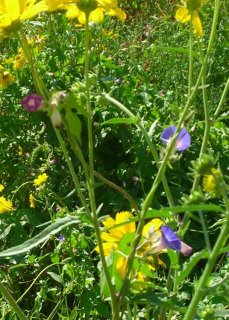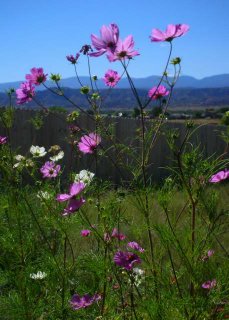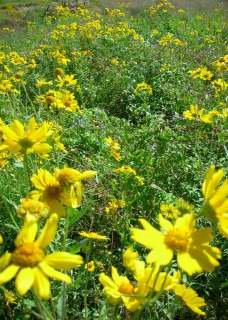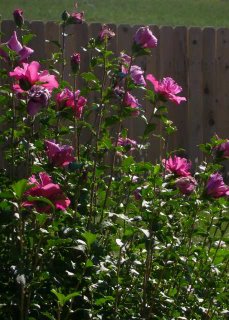 What’s blooming in the area: Lance-leaf yellow brush, datura, purple aster, tahokia daisy, ragweed, Russian thistle, golden hairy aster, bigleaf globeflower, purple mat, large white roses of Sharon, roses, purple salvia, sweet peas, heavenly blue and wild morning glories, silverlace vine, Maximilian and native sunflowers. Áñil del muerto smells late in day, especially if no wind; it was not perceptible until flowers began to die. Hay baled in one orchard; red apples visible in another. Two older men pulled pigweed and burned when they had large enough piles; stacks at sheep house are curing nicely, waiting for wind to scatter seed.
What’s blooming in the area: Lance-leaf yellow brush, datura, purple aster, tahokia daisy, ragweed, Russian thistle, golden hairy aster, bigleaf globeflower, purple mat, large white roses of Sharon, roses, purple salvia, sweet peas, heavenly blue and wild morning glories, silverlace vine, Maximilian and native sunflowers. Áñil del muerto smells late in day, especially if no wind; it was not perceptible until flowers began to die. Hay baled in one orchard; red apples visible in another. Two older men pulled pigweed and burned when they had large enough piles; stacks at sheep house are curing nicely, waiting for wind to scatter seed.What’s blooming in my garden, looking north: Black-eyed Susan, gloriosa daisy, blanket flower, chocolate flower, perky Sue, fern-leaf yarrow, Mexican hat, yellow cosmos, creeping zinnia, nasturtium, lance-leaf coreopsis, columbine, chrysanthemum, miniature rose (Rise and Shine).
Looking east: Garlic chives, California poppy, crackerjack marigold, tall zinnias, winecup, large flowered soapwort, pink bachelor button, larkspur, autumn joy sedum, Shirley poppy, sweet alyssum.
Looking south: Crimson rambler morning glory, sensation cosmos, heath aster.
Looking west: White phlox (David), frikarti aster, lead plant, catmint, Russian sage, purple ice plant, young caryopteris.
Bedding plants: Dalhburg daisies, marigolds, sweet alyssum, snapdragons, petunias, profusion zinnia, nicotiana.
Animal sightings: Gecko, ants, flying and leaping grasshoppers, flies, horse. Bees, including bumble bee, move to asters in afternoon.
Weather: Temperatures, colder in night; have already killed my grape leaves. A friend in a settlement to the south says her hybrid tomatoes have been killed, but not the heritage Brandywine. Neighbor split wood yesterday; smell of wood smoke in the morning. Despite rain Wednesday and Friday, grassfire near big arroyo late Saturday afternoon was quickly contained.
Weekly update: Morning glories are another meso-American plant flourishing in this year’s cool summer and early fall.
I’ve had the most success with Crimson Rambler. Seed I bought two years ago, but sowed this spring, is blooming everywhere, hanging over pots, creeping along the retaining wall, and scaling any plant it strikes. With changing sun angles, the pots are shaded longer so flowers remain open most of the day.
Heavenly Blue is the name everyone associates with morning glories. Several years ago, a man down the road developed an intensively cultivated vegetable plot and planted the blue flowers along the vertical board front fence where they naturalized. When he moved, the next renter converted the garden into a dog run and systematically rooted out the vine, leaving the usual pigweed and bare dirt yard.
This year someone in the village seeded an annual bed a bit higher than the road. The morning glories started opening the end of July along a wire strung above a two foot wall. By mid-September, a sheet of backlit blue flowers filled the space between the support and the wall.
In the past in Michigan and New Jersey, I bought mixed packages. Instead of multicolored patches, I discovered only one color would bloom, sometimes red, sometimes purple, but never both, and never, ever white. Apparently, they were sensitive to the environment, and depending on sun, rain, and atmosphere, the seed that thrived would vary by year in the same location.
One thing that never varies in the village is bindweed, which starts putting out its pink or white round flowers the end of May. This year, small scarlet funnels also appeared along farmers’ fences the first of August.
A few weeks ago I discovered ivy-leaved morning glories in the ditch up the road when I went to take pictures of áñil del muerto. Last weekend, I found them mixed with pink and white streaked trumpets, which a USDA guide suggests may be hedge bindweed (Convolvulus sepium). However, it looked like the 1970 map showed them on the other side of the Sangre de Cristo and Cimarron ranges.
I’ll probably never know the origin of the other wild members of the convolvulus family. It’s difficult enough to know the commercial varieties. Morning glories don’t readily cross-breed, but they do mutate. Heavenly Blue is a selection of the perennial Ipomoea tricolor, which some call Ipomoea violacea. It’s the species that’s attracted the most research because its seeds contain LSD.
Crimson Rambler is probably not the same, if only because it’s not listed by the most authoritative psychedelic writers. More likely it’s the annual Ipomoea purpurea. However, most catalogs group it with Heavenly Blue because a morning glory’s a morning glory. This far north, they all die in the fall anyway. Even so, the purpurea have been more affected by this week’s cold temperatures than the tricolor.
The red flowers with arrowhead leaves are Ipomoea coccinea, while the tiny, blue ones with big, three-lobed leaves are Ipomoea hederacea. Both are available by mail order, but I’ve never seen either sold here. So who knows how they got here, the one twining through fences edging three roads, the other only in the proto-arroyo.
No one asks where bindweed comes from. Few want to know it’s Convolvulus arvensis. Still its profuse flowers scrambling over the ground delight, so long as it’s someone else’s land.
Notes: United States Department of Agriculture, Agricultural Research Service. Selected Weeds of the United States, 1970, reprinted by Dover Publications as Common Weeds of the United States in 1971.


